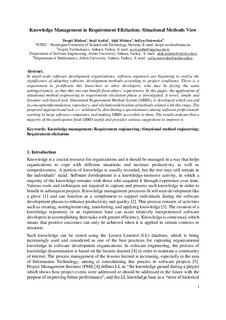| dc.contributor.author | Mishra, Deepti | |
| dc.contributor.author | Aydin, Secil | |
| dc.contributor.author | Mishra, Alok | |
| dc.contributor.author | Ostrovska, Sofiya | |
| dc.date.accessioned | 2019-02-13T14:36:06Z | |
| dc.date.available | 2019-02-13T14:36:06Z | |
| dc.date.created | 2017-10-14T14:10:58Z | |
| dc.date.issued | 2018 | |
| dc.identifier.citation | Computer Standards & Interfaces. 2018, 56 (February 2018), 49-61. | nb_NO |
| dc.identifier.issn | 0920-5489 | |
| dc.identifier.uri | http://hdl.handle.net/11250/2585290 | |
| dc.description.abstract | In small-scale software development organizations, software engineers are beginning to realize the significance of adapting software development methods according to project conditions. There is a requirement to proliferate this know-how to other developers, who may be facing the same settings/context, so that they too can benefit from others’ experiences. In this paper, the application of situational method engineering in requirements elicitation phase is investigated. A novel, simple and dynamic web-based tool, Situational Requirement Method System (SRMS), is developed which can aid in conception/formulation, repository, and elicitation/derivation of methods related with this stage. The proposed approach and tool are validated by distributing a questionnaire among software professionals working in large software companies, and making SRMS accessible to them. The results indicate that a majority of the participants finds SRMS useful and provides various suggestions to improve it. | nb_NO |
| dc.language.iso | eng | nb_NO |
| dc.publisher | Elsevier | nb_NO |
| dc.relation.uri | https://reader.elsevier.com/reader/sd/pii/S092054891630229X?token=D65509FDE47283A202ED4D3945690BC3781684F649893474A2BDD3EEE2D16354C29A382B5A85891EABAF7506C8945182 | |
| dc.rights | Attribution-NonCommercial-NoDerivatives 4.0 Internasjonal | * |
| dc.rights.uri | http://creativecommons.org/licenses/by-nc-nd/4.0/deed.no | * |
| dc.title | Knowledge management in requirement elicitation: Situational methods view | nb_NO |
| dc.type | Journal article | nb_NO |
| dc.type | Peer reviewed | nb_NO |
| dc.description.version | submittedVersion | nb_NO |
| dc.source.pagenumber | 49-61 | nb_NO |
| dc.source.volume | 56 | nb_NO |
| dc.source.journal | Computer Standards & Interfaces | nb_NO |
| dc.source.issue | February 2018 | nb_NO |
| dc.identifier.doi | 10.1016/j.csi.2017.09.004 | |
| dc.identifier.cristin | 1504632 | |
| dc.description.localcode | © 2017. This is the authors’ accepted and refereed manuscript to the article. Locked until 11.09.2019 due to copyright restrictions. This manuscript version is made available under the CC-BY-NC-ND 4.0 license http://creativecommons.org/licenses/by-nc-nd/4.0/ | nb_NO |
| cristin.unitcode | 194,63,10,0 | |
| cristin.unitname | Institutt for datateknologi og informatikk | |
| cristin.ispublished | true | |
| cristin.fulltext | preprint | |
| cristin.qualitycode | 1 | |

